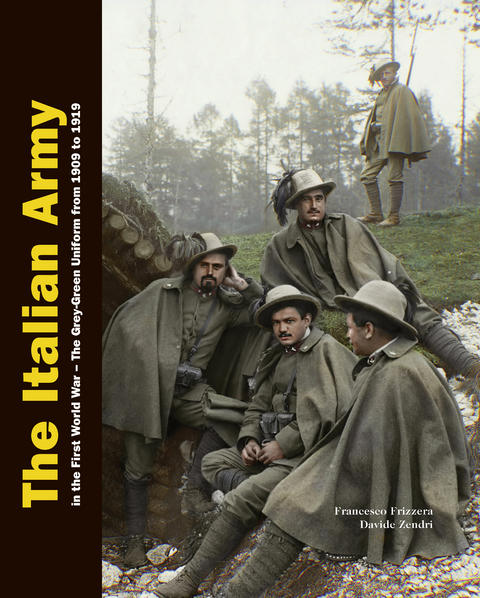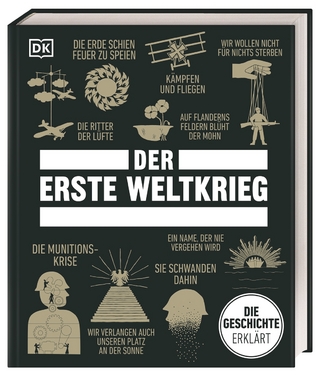
The Italian Army in the First World War
The Grey-Green Uniform from 1909 to 1919
Seiten
2022
Verlag Militaria
978-3-903341-22-7 (ISBN)
Verlag Militaria
978-3-903341-22-7 (ISBN)
At the outbreak of the First World War in 1914 the Italian Army comprised just under 300,000 soldiers. Four years later more than 5.9 million men had been mobilised and sent to the various fronts. Some military operations in the occupied zone continued until 1919.
The Italian military went to war inadequately prepared. The introduction of a new field uniform in 1909 and the army’s recent experiences during the Italo-Turkish War (1911-12) against the Ottoman Empire had advanced the modernisation of equipment. Nonetheless, compared to the military capabilities of the major European powers Italy’s Army had only moderate striking power, while its domestic industry lacked the capacity to meet the challenges of mass warfare. This led to delays and fluctuations in textile supplies but also to the emergence of new leaders.
With illustrations of more than 350 uniforms, caps, hats and helmets, this work shows how the appearance of the Italian Army changed as the war progressed. The pieces shown in the book come from the collections of the Museo Storico Italiano della Guerra (Italian War History Museum) in Rovereto, as well as other public and private collections. They illustrate the uniforms of the traditional formations (infantry, Granatieri, Alpini, Bersaglieri, artillery, cavalry, Carabinieri, Financial Guard, engineers, medical and logistical services) as well as with those of the newer branches of service that had emerged as a result of modern warfare (mortar formations, machine-gun troops, Arditi, Military Air Corps). In addition, they provide a comprehensive view of the various special formations that were attached to the Italian Army, with particular focus on the volunteer formations (Garibaldian Volunteers, cycling and motorised corps, Czechoslovakian legionaries, Italian Expeditionary Corps in the Far East).
This lavishly illustrated work shows uniforms, caps and steel helmets, covering all the models of the army’s field uniform from the time the new uniform was introduced to the end of the war. Contemporary black-and-white photographs show how the items of dress were worn in action. In addition, the two volumes include numerous short biographies and bequests from prominent figures such as Luigi Cadorna, Armando Diaz, Gabriele d’Annunzio, Cesare Battisti, Damiano Chiesa, Fabio Filzi, Ettore Lajolo and the Calvi brothers, and formations like the 87th Air Force Squadron “Serenissima”, which flew a daring mission over the enemy city of Vienna in August 1918.
The collections, along with a great deal of hitherto unpublished archive material, provide the reader with an authentic picture of the Italian Army’s organisation and its uniforms during the war, as well as showing the shortfalls and subsequent advances in its equipment.
The Italian military went to war inadequately prepared. The introduction of a new field uniform in 1909 and the army’s recent experiences during the Italo-Turkish War (1911-12) against the Ottoman Empire had advanced the modernisation of equipment. Nonetheless, compared to the military capabilities of the major European powers Italy’s Army had only moderate striking power, while its domestic industry lacked the capacity to meet the challenges of mass warfare. This led to delays and fluctuations in textile supplies but also to the emergence of new leaders.
With illustrations of more than 350 uniforms, caps, hats and helmets, this work shows how the appearance of the Italian Army changed as the war progressed. The pieces shown in the book come from the collections of the Museo Storico Italiano della Guerra (Italian War History Museum) in Rovereto, as well as other public and private collections. They illustrate the uniforms of the traditional formations (infantry, Granatieri, Alpini, Bersaglieri, artillery, cavalry, Carabinieri, Financial Guard, engineers, medical and logistical services) as well as with those of the newer branches of service that had emerged as a result of modern warfare (mortar formations, machine-gun troops, Arditi, Military Air Corps). In addition, they provide a comprehensive view of the various special formations that were attached to the Italian Army, with particular focus on the volunteer formations (Garibaldian Volunteers, cycling and motorised corps, Czechoslovakian legionaries, Italian Expeditionary Corps in the Far East).
This lavishly illustrated work shows uniforms, caps and steel helmets, covering all the models of the army’s field uniform from the time the new uniform was introduced to the end of the war. Contemporary black-and-white photographs show how the items of dress were worn in action. In addition, the two volumes include numerous short biographies and bequests from prominent figures such as Luigi Cadorna, Armando Diaz, Gabriele d’Annunzio, Cesare Battisti, Damiano Chiesa, Fabio Filzi, Ettore Lajolo and the Calvi brothers, and formations like the 87th Air Force Squadron “Serenissima”, which flew a daring mission over the enemy city of Vienna in August 1918.
The collections, along with a great deal of hitherto unpublished archive material, provide the reader with an authentic picture of the Italian Army’s organisation and its uniforms during the war, as well as showing the shortfalls and subsequent advances in its equipment.
| Erscheinungsdatum | 30.06.2022 |
|---|---|
| Verlagsort | Wien |
| Sprache | englisch |
| Maße | 260 x 295 mm |
| Gewicht | 4500 g |
| Einbandart | gebunden im Schuber |
| Themenwelt | Sachbuch/Ratgeber ► Geschichte / Politik ► Neuzeit bis 1918 |
| Geisteswissenschaften ► Geschichte | |
| Schlagworte | First World War • italian army • uniforms |
| ISBN-10 | 3-903341-22-3 / 3903341223 |
| ISBN-13 | 978-3-903341-22-7 / 9783903341227 |
| Zustand | Neuware |
| Haben Sie eine Frage zum Produkt? |
Mehr entdecken
aus dem Bereich
aus dem Bereich
vom Ende des Mittelalters bis 1806
Buch | Softcover (2023)
C.H.Beck (Verlag)
CHF 16,80
Die frühen Romantiker und die Erfindung des Ich
Buch | Hardcover (2022)
C. Bertelsmann (Verlag)
CHF 41,95


